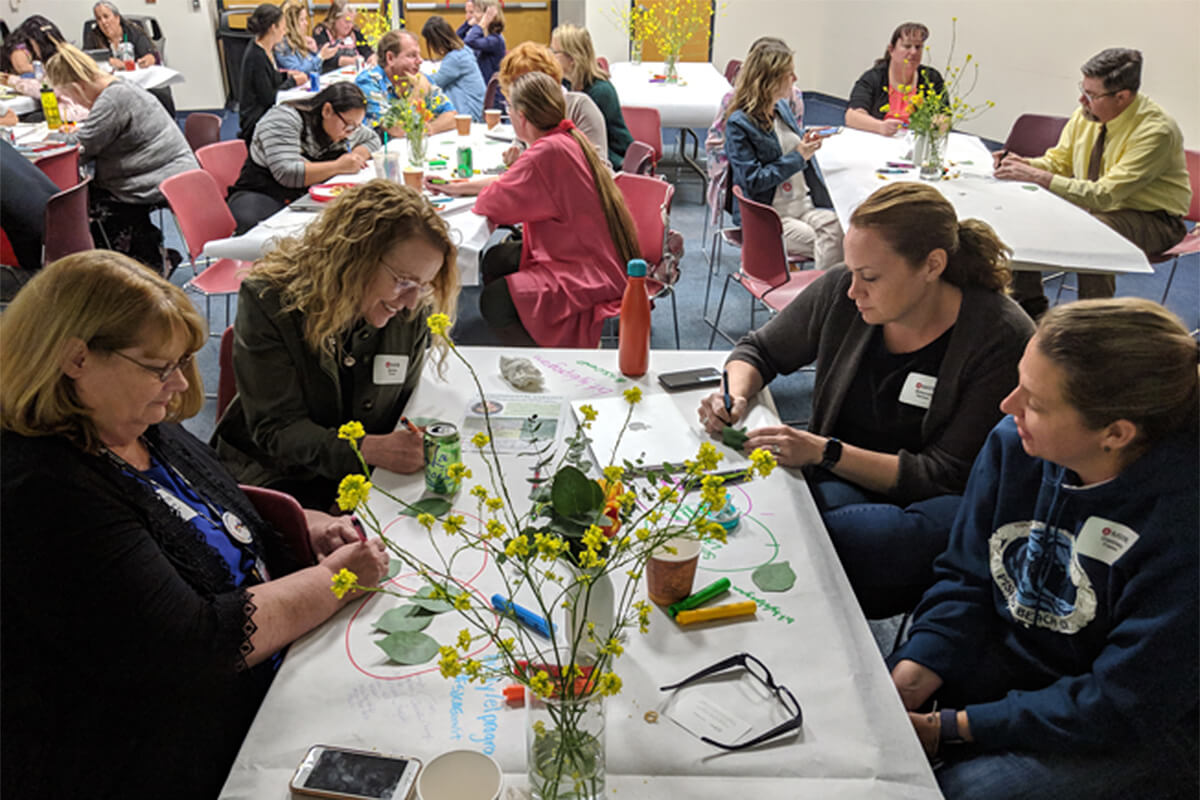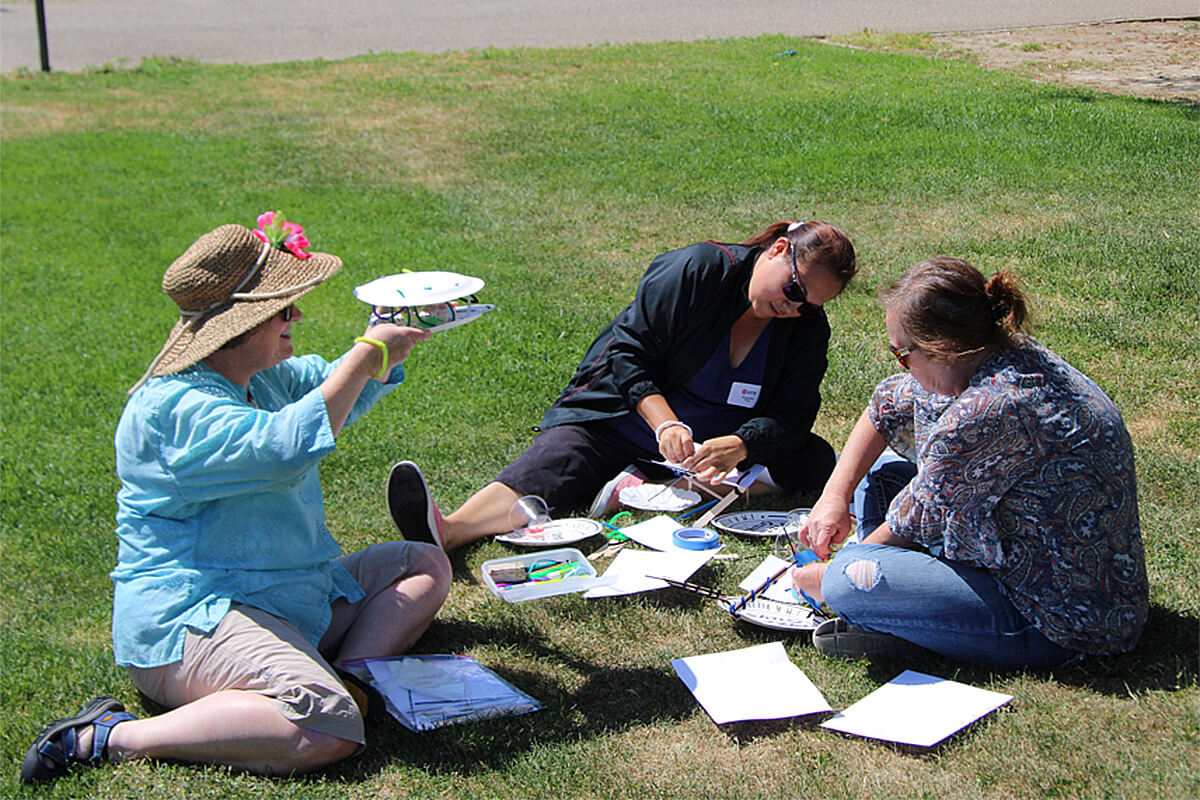“When we try to pick out anything by itself, we find it hitched to everything else in the Universe.” ~John Muir
In April 2019, nearly 70 K–12 educators from Amador, Calaveras, San Joaquin, Stanislaus, and Tuolumne counties came to a special dinner in Stockton to learn about environmental justice, culturally responsive teaching, and the benefits of environmental education. Once the plates were cleared away, they took what they had learned from the experts they heard speak, and got right to work brainstorming ideas. What they had when they were done was a call to action.
Together, they gave themselves the challenge to bolster the development of their students’ environmental literacy by:
- including environmental issues in classroom lessons;
- providing students with more outdoor and hands-on learning;
- practicing sustainability by utilizing recycling programs, composting, and sustainable food practices; and
- engaging and partnering with local community-based organizations to create a rich, place-based context for environmental literacy development.
And that was just the beginning. This dinner at the San Joaquin County Office of Education (SJCOE) was the start of a three-year commitment by these educators to improve environmental literacy in their schools.

This endeavor is part of the California Department of Education’s California Environmental Literacy Project grant. As one of the recipients of the grant, the SJCOE organized events and activities that the group of educators from California’s Region 6 would continue to take part in from spring 2019 through the duration of the three-year grant. The goals of the grant work include:
- establishing an environmental literacy community of practice to support the implementation of California’s Environmental Principles & Concepts (EP&Cs) into traditional course disciplines;
- raising awareness and evaluating the effectiveness of available curriculum resources and activities aimed at developing students’ environmental literacy;
- supporting the development of effective and appropriate pedagogical approaches for addressing environmental literacy; and
- encouraging sharing of learnings and participation in regional networks and programs, such as California County Superintendents Educational Services Association, the California Subject Matter Project, the California AfterSchool Network, and the California Department of Education’s Green Ribbon School Award Program.
Amanda Ford, transformative climate communities program manager for the City of Stockton, summarized the work she is doing to bring awareness to environmental justice issues in the city. She highlighted an important tool developed on behalf of CalEPA called CalEnviroScreen 3.0. This platform visually displays data on pollution burdens and population characteristics within California, providing the user with data to consider exposure to harmful toxins and pollutants.
Steven Drouin, assistant professor of education at CSU Stanislaus, shared his experience with engaging and motivating students by considering their culture and interest during the lesson-planning process.
Sharing ideas from the work of Dr. Gloria Ladson-Billings, he reminded us all that an effective lesson is just as much about who we are teaching as what we are teaching.
Rita Bell, director of education for the Monterey Bay Aquarium, made the case for how important it is to expose students to environmental education as part of their K–12 experience. She highlighted the connection of the EP&Cs to California’s Next Generation Science Standards and discussed the benefits of student engagement with environmental issues in their community. She made the case for how environment-based learning supports students to:
- develop confidence in themselves;
- develop the knowledge and skills to be successful in their lives after high school;
- improve their relationship with school; and
- foster an appreciation for their local and global environment.

On a Saturday in May, the 70 educators from Region 6 came back to Stockton for the second event. The two goals for this day were to expose teachers to a grade-band specific lesson that focused on integrating the EP&Cs, and to learn from experienced naturalists about strategies that engage students in observing and connecting to nature in their schoolyard. The day started off with four teacher leaders from four counties involved in the grant who led participating teachers through a lesson that included both the EP&Cs and NGSS.
Allison Collins, principal the San Joaquin Outdoor Education School, presented the Lawrence Hall of Science’s BEETLES activity Making Observations. This session provided teachers with the pedagogical moves to take their students out of their classrooms and into the schoolyard to notice and inquire about the ecosystem around them. SJCOE resident naturalists led breakout sessions for the teachers. They did a wonderful job boosting teachers’ confidence and giving suggestions on how to engage their students in this practice.
The final meeting of the Region 6 community of practice was an environmental literacy symposium. This day provided teachers with exposure to existing environmental education curriculum and activities that teachers could bring back to their classrooms.
Rudy Escobar, science coordinator from Stanislaus County Office of Education, presented on the air quality monitoring network PurpleAir. In this session, teachers explored the real-time data that PurpleAir provides as a means to monitor air quality locally and statewide. Jessica Hewitt, principal of Foothill Horizons Outdoor School, and naturalist Karena David presented a session entitled FBI (Fungus, Bacteria, and Invertebrates). Teachers were given the opportunity to dig through composting soil and identify the “FBI agents” responsible for breaking down food waste to create nutrient rich soil. Teachers left the symposium with many new ideas to try in their classroom to develop environmental literacy with their students.
SJCOE will continue the environmental literacy community of practice over the next two years with the same cadre of teachers. Each year, the intent is to deepen our understanding of how to engage students in the practice of developing environmental literacy. In September 2019, we will learn from John Muir Laws—one of the premier nature journalists in the country. This will be followed by the development of more EP&Cs-infused lessons, and exposure to how Sacramento County Office of Education has been exploring how to integrate science and history–social science via their environmental literacy project.
We are so excited for the year ahead!



